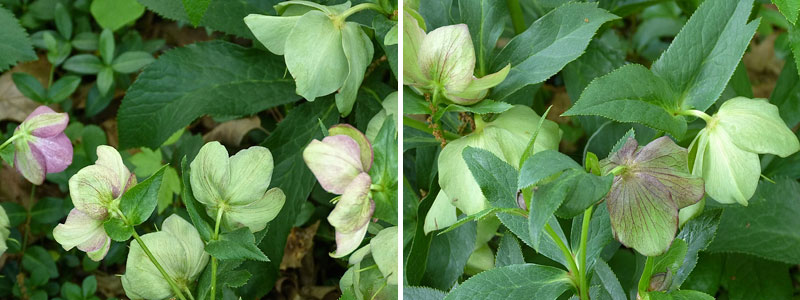Arbor Garden, 2016
 Sunday, April 17, 2016 at 8:30PM
Sunday, April 17, 2016 at 8:30PM The Arbor Garden, originally called the Lady Garden, is eight years old. It has taken that long for me to develop a clear vision of what I want. While it has not yet become the enclosed garden room I dream about, the plants along the periphery are growing; and it is easier to see what it will become. The Arbor Garden has always been one of my favorite places to sit and enjoy wildlife, but with rough edges and a large sloping layout, it has never been particularly photogenic. Here are some recent shots taken in and around the space, and at the end of the post I'll show you some views taken when the area was first being developed, so you can see some of the changes.
Overview of the Arbor Garden taken from the patio:
Steps leading from the patio to the Arbor Garden:
Some plantings beside the steps:
A close-up of 'Red Dragon' Persicaria, seen on the right in the above image:
Chinese Snowball Viburnum and Philadelphus, AKA Mock Orange and English Dogwood, next to the Arbor Garden:

Here is a view of the Mock Orange taken from within the Arbor Garden:
Hellebores grow around the Mock Orange. They have been blooming for months and have mostly faded to greenish-white, but they are still beautiful. Their lovely foliage is evergreen and will give the ground a green covering when the flowers are gone:
Here is the entrance to the Arbor Garden:
One of the first things I added to the Arbor Garden was this large urn. I put a fern in it every year:
This is a current view of the sitting area and the arbor swing:
Here is a closer view of the small sitting area near the arbor swing - don't miss the chandelier!
The plant in the green pot is 'Banana Boat' Creeping Broad-leaved Sedge:
I have a couple of small green chairs on the landing, which is a step down from the arbor swing. This chair holds a pot of plants, which have not grown enough yet to really show up. I also have planted some woodland phlox and some dwarf mondo grass between the pavers here::
Moss is spreading to cover the ground around the large urn in the middle of the Arbor Garden. A number of 'stepable' ground covers are intermingling with the moss and each other. Hopefully, in another year one will not see any bare earth. These are some of the ground covers, as well as some other plants that are planted in pots in the Arbor Garden: Clockwise from top: Maidenhair fern, Leopard Plant and Variegated Carex grow together in a large red pot; Creeping Jenny ((Lysimachia nummularia 'Aurea') and purple clover blend together; Creeping Jenny and Oxalis; 'Ogon' Japanese Sedum and Ajuga; Impatiens and Dusty Miller are easy annuals growing in pots.
Clockwise from top: Maidenhair fern, Leopard Plant and Variegated Carex grow together in a large red pot; Creeping Jenny ((Lysimachia nummularia 'Aurea') and purple clover blend together; Creeping Jenny and Oxalis; 'Ogon' Japanese Sedum and Ajuga; Impatiens and Dusty Miller are easy annuals growing in pots.
Finally, here are a few views taken years ago when the Arbor Garden was much younger. The top image was taken in May, 2008, very soon after the arbor swing was completed. Some stonework was done, and the urn was in place. The views below the top image were all taken in 2010:
You may also enjoy reading some previous posts about the Arbor (Lady) Garden:
Rocking Along in the Lady Garden



